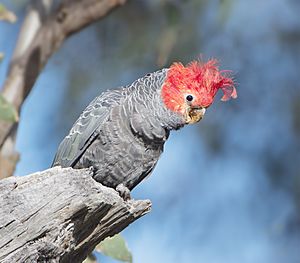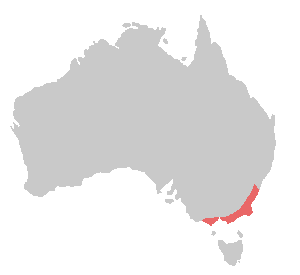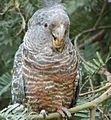Gang-gang cockatoo facts for kids
Quick facts for kids Gang-gang cockatoo |
|
|---|---|
 |
|
| Adult male in the Australian Capital Territory | |
| Conservation status | |
| Scientific classification | |
| Genus: |
Callocephalon
|
| Species: |
fimbriatum
|
 |
|
| Range of C. fimbriatum | |
The gang-gang cockatoo (Callocephalon fimbriatum) is a special type of cockatoo found in the cooler, wetter forests and woodlands of south-eastern Australia. It especially likes mountain areas. This bird is mostly grey, but the male has a bright red head and a fluffy red crest. Females have a grey head and a small grey crest. The gang-gang cockatoo is the animal symbol of the Australian Capital Territory. You can easily spot it by its unique call, which sounds a bit like a squeaky gate or a cork popping from a bottle.
The name gang-gang comes from an Aboriginal language in New South Wales. It probably sounds like the bird's own call.
Contents
What Does a Gang-gang Cockatoo Look Like?
The gang-gang cockatoo is a grey bird with a soft, wispy crest. The male bird has a bright red head and crest. Female birds have a dark grey head and crest. The feathers on their undersides have yellow or pink edges. The feathers on their upper parts are a slightly lighter grey, which makes the bird look a bit striped.
Young male gang-gangs have brighter crowns and shorter crests. Otherwise, they look a lot like adult females. These birds are usually easy to tell apart from other cockatoos. However, when flying, they might look a bit like a Galah. Gang-gangs are very social birds, but they are not usually very noisy.
Where Do Gang-gang Cockatoos Live?
Gang-gang cockatoos live only in the coastal areas of south-eastern Australia. They used to live on King Island near Tasmania, but they are no longer found there. They were also brought to Kangaroo Island by people.
These birds prefer forests and woodlands in the mountains. They like places with lots of dense shrubs under the trees. During winter, they fly short distances to more open areas. However, they must return to denser forests to breed. This is because they need tall trees to build their nests.
Gang-gang Cockatoo Life Cycle
How Do Gang-gang Cockatoos Breed?
Unlike most other cockatoos, gang-gangs build their nests in young, strong trees. The female uses her powerful beak to dig out a nesting hole. They also breed high up in the canopy (the top branches) of most trees.
Protecting Gang-gang Cockatoos
The number of gang-gang cockatoos has gone down a lot in recent years. This is because their homes and feeding areas are being cleared across south-eastern Australia. Also, older trees with hollows, which they need for nesting, are being lost.
Because of this, the gang-gang cockatoo is now considered a vulnerable species in New South Wales. This means there are laws to protect them and their homes. It is against the law for anyone to harm their habitat. This includes removing any part of the area where they live or visit.
Gallery
-
Male eating Acacia baileyana seeds
See also
 In Spanish: Cacatúa gang-gang para niños
In Spanish: Cacatúa gang-gang para niños







